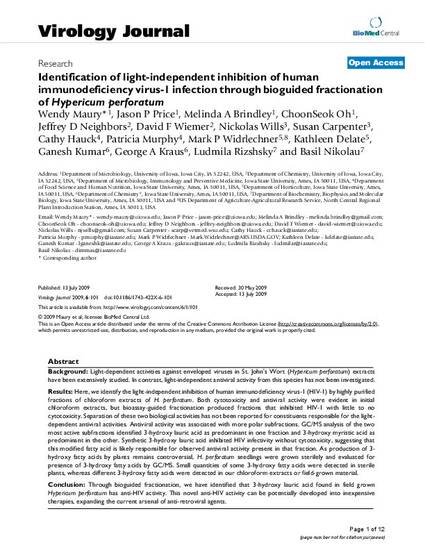
Article
Identification of light-independent inhibition of human immunodeficiency virus-1 infection through bioguided fractionation of Hypericum perforatum
Virology Journal
Document Type
Article
Disciplines
Publication Version
Published Version
Publication Date
7-13-2009
DOI
10.1186/1743-422X-6-101
Abstract
BackgroundLight-dependent activities against enveloped viruses in St. John's Wort (Hypericum perforatum) extracts have been extensively studied. In contrast, light-independent antiviral activity from this species has not been investigated.
Results Here, we identify the light-independent inhibition of human immunodeficiency virus-1 (HIV-1) by highly purified fractions of chloroform extracts of H. perforatum. Both cytotoxicity and antiviral activity were evident in initial chloroform extracts, but bioassay-guided fractionation produced fractions that inhibited HIV-1 with little to no cytotoxicity. Separation of these two biological activities has not been reported for constituents responsible for the light-dependent antiviral activities. Antiviral activity was associated with more polar subfractions. GC/MS analysis of the two most active subfractions identified 3-hydroxy lauric acid as predominant in one fraction and 3-hydroxy myristic acid as predominant in the other. Synthetic 3-hydroxy lauric acid inhibited HIV infectivity without cytotoxicity, suggesting that this modified fatty acid is likely responsible for observed antiviral activity present in that fraction. As production of 3-hydroxy fatty acids by plants remains controversial, H. perforatum seedlings were grown sterilely and evaluated for presence of 3-hydroxy fatty acids by GC/MS. Small quantities of some 3-hydroxy fatty acids were detected in sterile plants, whereas different 3-hydroxy fatty acids were detected in our chloroform extracts or field-grown material.
ConclusionThrough bioguided fractionation, we have identified that 3-hydroxy lauric acid found in field grown Hypericum perforatum has anti-HIV activity. This novel anti-HIV activity can be potentially developed into inexpensive therapies, expanding the current arsenal of anti-retroviral agents.
Rights
This is an Open Access article distributed under the terms of the Creative Commons Attribution License (http://creativecommons.org/licenses/by/2.0),
which permits unrestricted use, distribution, and reproduction in any medium, provided the original work is properly cited.
Copyright Owner
Maury et al
Copyright Date
2009
Language
en
File Format
application/pdf
Citation Information
Wendy Maury, Jason P. Price, Melinda A. Brindley, ChoonSeok Oh, et al.. "Identification of light-independent inhibition of human immunodeficiency virus-1 infection through bioguided fractionation of Hypericum perforatum" Virology Journal Vol. 6 (2009) p. 101 Available at: http://works.bepress.com/basil-nikolau/21/

This article is from Virology Journal 6 (2009): 101, doi:10.1186/1743-422X-6-101. Posted with permission.